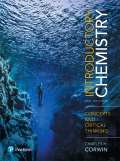
(a)
Interpretation:
The solubility product of saturated solution of copper carbonate is to be stated.
Concept introduction:
In a
(b)
Interpretation:
The solubility product of saturated solution of zinc carbonate is to be stated.
Concept introduction:
In a chemical reaction, when the rates of both forward and reverse reaction are equal then the chemical reaction is said to be at equilibrium. They are reversible in nature. Equilibrium constant is denoted as
(c)
Interpretation:
The solubility product of saturated solution of aluminium carbonate is to be stated.
Concept introduction:
In a chemical reaction, when the rates of both forward and reverse reaction are equal then the chemical reaction is said to be at equilibrium. They are reversible in nature. Equilibrium constant is denoted as
Want to see the full answer?
Check out a sample textbook solution
Chapter 16 Solutions
EBK INTRODUCTORY CHEMISTRY
- 12.19 For each of the following equations, write the equilibrium expression for the reverse reaction. 2C(s) + O,(g)^2CO(g) AgCl(s)5=BAg+(aq) + Crarrow_forwardA sample of AgNO3 (aq) is mixed with a sample of NaCl (aq) to make a solution where theconcentration of AgNO3 (aq) is 0.10 M and NaCl (aq) is 0.090 M. Calculate the reactionquotient, Q, for AgCl(s). What I got so far: (Please tell me if I am solving the problem correctly) AgNO3(aq)+NaCl(aq)->AgCl(s) (0.10M) (0.090) ? Q=[AgCl]/[AgNO3][NaCl] Q=[x]/[0.10M][0.090M]arrow_forwardWhat is the value of Kp at 675.00 K?arrow_forward
- What is the equlibrium constant for the following reaction at a temperature of 298 K? HCl(g) + H2O(l) = H3O+(aq) + Cl-(aq) Group of answer choices between -1.0 x 105 and -1.0 x 106 between -1.0 x 106 and -1.0 x 107 between 0 and -1.0 x 105 0 between 1.0 x 106 and 1.0 x 107 between 1.0 x 105 and 1.0 x 106 between 0 and 1.0 x 105arrow_forwardPredict whether the following reaction leads to an increase or a decrease in entropy. Ag+(aq) + Cl-(aq) → AgCl(s)arrow_forwardIf the solubility of silver carbonate (Ag2CO3) is 1.3 x 10-4 mol/L, calculate the Kps.arrow_forward
- The solubility of silver chloride can be increased by dissolving it in a solution containing ammonia. AgCl (s) Ag+ (aq) + Cl- (aq) K1 = 1.6 x 10-10 Ag+ (aq) + 2NH3 (aq) Ag(NH3)2+ (aq) K2 = 1.5 x 107What is the value of the equilibrium constant for the overall reaction? AgCl (s) + 2NH3 (aq) Ag(NH3)2+ (aq) + Cl- (aq) Knet = ?arrow_forwardWhat is the value of kp?arrow_forwardWhat is the equilibrium constant expression for the reaction:3 Fe(s) + 4 H2O (g)⟷ Fe3O4 (s) + 4 H2 (g)arrow_forward
- Write the equilibrium constant expression for the following equation: SnO2(s) + 2 CO(g) <=> Sn(s) + 2 CO2 (g)arrow_forwardWhat is the E º, ΔG º, and K at 258C of the reaction: 2MnO4^- (aq) + 4H+ (aq) + Cl2 (g) = 2Mn^2+ + 2ClO3^- (aq) + 2H2Oarrow_forwardWrite the equilibrium constant expression, Kc, for the reaction: 2Cu2+(aq) + Sn2+(aq) ⇄ 2Cu+(aq) + Sn4+(aq) Kc = ?arrow_forward
 Chemistry for Engineering StudentsChemistryISBN:9781337398909Author:Lawrence S. Brown, Tom HolmePublisher:Cengage Learning
Chemistry for Engineering StudentsChemistryISBN:9781337398909Author:Lawrence S. Brown, Tom HolmePublisher:Cengage Learning Chemistry & Chemical ReactivityChemistryISBN:9781337399074Author:John C. Kotz, Paul M. Treichel, John Townsend, David TreichelPublisher:Cengage Learning
Chemistry & Chemical ReactivityChemistryISBN:9781337399074Author:John C. Kotz, Paul M. Treichel, John Townsend, David TreichelPublisher:Cengage Learning Chemistry & Chemical ReactivityChemistryISBN:9781133949640Author:John C. Kotz, Paul M. Treichel, John Townsend, David TreichelPublisher:Cengage Learning
Chemistry & Chemical ReactivityChemistryISBN:9781133949640Author:John C. Kotz, Paul M. Treichel, John Townsend, David TreichelPublisher:Cengage Learning General, Organic, and Biological ChemistryChemistryISBN:9781285853918Author:H. Stephen StokerPublisher:Cengage Learning
General, Organic, and Biological ChemistryChemistryISBN:9781285853918Author:H. Stephen StokerPublisher:Cengage Learning Introductory Chemistry: An Active Learning Approa...ChemistryISBN:9781305079250Author:Mark S. Cracolice, Ed PetersPublisher:Cengage Learning
Introductory Chemistry: An Active Learning Approa...ChemistryISBN:9781305079250Author:Mark S. Cracolice, Ed PetersPublisher:Cengage Learning




